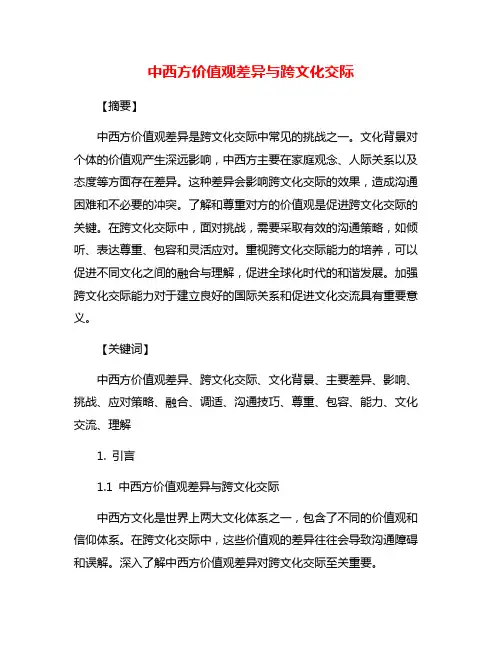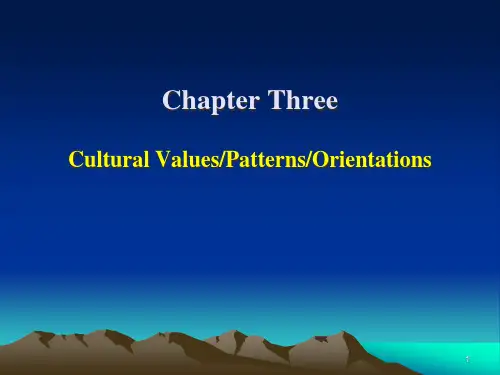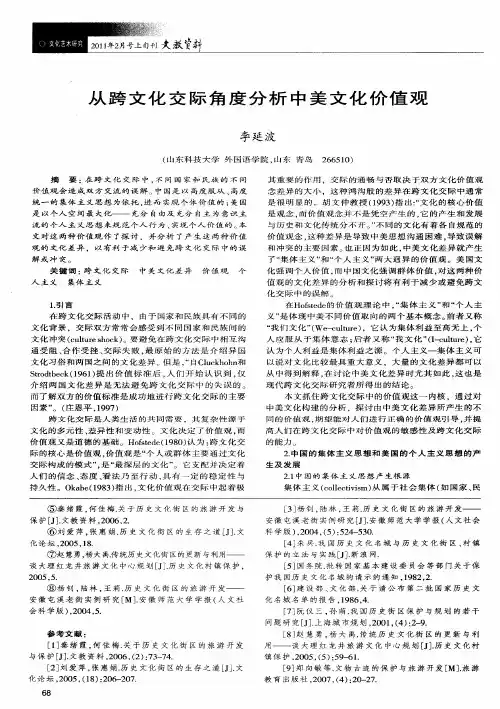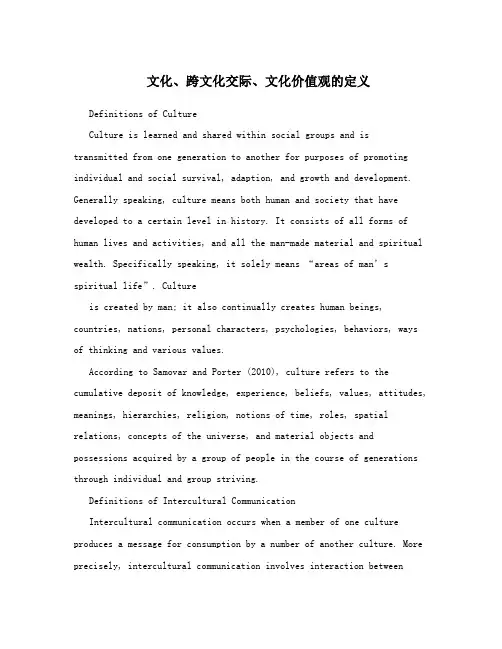跨文化交际--价值观
- 格式:ppt
- 大小:805.00 KB
- 文档页数:27

中西方价值观差异与跨文化交际【摘要】中西方价值观差异是跨文化交际中常见的挑战之一。
文化背景对个体的价值观产生深远影响,中西方主要在家庭观念、人际关系以及态度等方面存在差异。
这种差异会影响跨文化交际的效果,造成沟通困难和不必要的冲突。
了解和尊重对方的价值观是促进跨文化交际的关键。
在跨文化交际中,面对挑战,需要采取有效的沟通策略,如倾听、表达尊重、包容和灵活应对。
重视跨文化交际能力的培养,可以促进不同文化之间的融合与理解,促进全球化时代的和谐发展。
加强跨文化交际能力对于建立良好的国际关系和促进文化交流具有重要意义。
【关键词】中西方价值观差异、跨文化交际、文化背景、主要差异、影响、挑战、应对策略、融合、调适、沟通技巧、尊重、包容、能力、文化交流、理解1. 引言1.1 中西方价值观差异与跨文化交际中西方文化是世界上两大文化体系之一,包含了不同的价值观和信仰体系。
在跨文化交际中,这些价值观的差异往往会导致沟通障碍和误解。
深入了解中西方价值观差异对跨文化交际至关重要。
中西方文化背景的差异影响着人们对世界的看法和价值观念。
在西方文化中,个人主义被强调,个人的独立性和自由被视为重要。
而在中国文化中,集体主义更受重视,强调个人与集体的关系和责任。
这种差异导致了中西方在人际关系、权利观念、时间观念等方面存在着较大的分歧。
这些价值观差异在跨文化交际中会带来许多挑战。
在交流过程中,可能会出现语言障碍、非语言沟通不当、文化误解等问题。
为了有效应对这些挑战,人们需要尊重对方的文化差异,倾听对方的观点,保持开放的心态。
通过文化融合和价值观调适,中西方的跨文化交际可以更加顺畅和有效。
通过加强跨文化交际能力,促进文化交流和理解,可以实现更好的沟通和合作。
在这个过程中,尊重和包容是跨文化交际的基础,沟通技巧则是实现文化交流的关键。
2. 正文2.1 文化背景对价值观的影响文化背景对价值观的影响是跨文化交际中一个非常重要的因素。
每个国家或地区的文化都有其独特的特点,这些特点会直接影响到人们对于价值观念的认知和看法。


跨文化交际中中美文化价值观差异一、本文概述随着全球化的日益推进,跨文化交际已成为现代社会中不可或缺的一部分。
中美两国,作为世界上最大的经济体和文化大国,其文化价值观的差异在跨文化交际中尤为显著。
本文旨在深入探讨跨文化交际中中美文化价值观的差异,以期为增进两国人民之间的相互理解和友好交流提供有益的参考。
本文首先将对中美两国的文化价值观进行概述,包括个人主义与集体主义、独立与依赖、竞争与合作等方面的差异。
随后,文章将结合具体案例,分析这些差异在跨文化交际中的具体表现和影响。
在此基础上,文章将探讨如何克服文化价值观差异带来的障碍,促进中美两国人民之间的有效沟通与合作。
通过本文的研究,我们希望能够为跨文化交际的实践者提供理论支持和实践指导,同时也为中美两国之间的文化交流与合作搭建起一座坚实的桥梁。
二、中美文化价值观差异的表现在跨文化交际中,中美文化价值观的差异体现在诸多方面,这些差异在日常交往、社会行为、思维模式以及价值取向上都有明显的表现。
在个人主义与集体主义上,美国文化倾向于个人主义,强调个人权利和自由,鼓励独立思考和自主行动。
个人在美国社会中被视为最重要的单位,个人的成就和价值往往被放在首位。
相比之下,中国文化则更强调集体主义,重视家庭和社会的和谐,个人的行为和决策往往需要考虑到集体的利益。
在权力距离上,美国文化倾向于低权力距离,即人们更倾向于平等和民主,尊重他人的观点,强调团队合作和共同参与。
而在中国文化中,高权力距离是一种常见的现象,人们往往尊重权威和传统,对领导者和长辈的决策持有高度的信任和尊重。
再次,对于不确定性的态度上,美国文化倾向于鼓励冒险和创新,对于不确定性和未知的事物持开放和探索的态度。
而在中国文化中,由于强调稳定和安全,人们往往对未知的事物持有谨慎和保守的态度。
在性别角色上,美国文化更加强调性别平等,鼓励女性追求自己的事业和梦想,男性也被期望在家庭中扮演更加平等的角色。
而在中国文化中,传统的性别角色分工仍然在一定程度上存在,男性被期望在职业上取得更大的成就,女性则更多地承担家庭责任。





文化、跨文化交际、文化价值观的定义Definitions of CultureCulture is learned and shared within social groups and istransmitted from one generation to another for purposes of promoting individual and social survival, adaption, and growth and development. Generally speaking, culture means both human and society that have developed to a certain level in history. It consists of all forms of human lives and activities, and all the man-made material and spiritual wealth. Specifically speaking, it solely means “areas of man’ssp iritual life”. Cultureis created by man; it also continually creates human beings, countries, nations, personal characters, psychologies, behaviors, ways of thinking and various values.According to Samovar and Porter (2010), culture refers to the cumulative deposit of knowledge, experience, beliefs, values, attitudes, meanings, hierarchies, religion, notions of time, roles, spatial relations, concepts of the universe, and material objects and possessions acquired by a group of people in the course of generations through individual and group striving.Definitions of Intercultural CommunicationIntercultural communication occurs when a member of one culture produces a message for consumption by a number of another culture. More precisely, intercultural communication involves interaction betweenpeople whose cultural perception and symbol systems are distinct enough to alter the communication event.Intercultural communication in its most basic form refers to an academic field of study and research. It seeks to understand how people from different countries and cultures behave, communicate and perceive the world around them. The definition of intercultural communication must also include strands of the field that contribute to it such as anthropology, cultural studies, psychology and communication.According to the definition from Wikipedia, the free encyclopedia, intercultural communication is a form of global communication. It is used to describe the wide range of communication problems that naturally appear within an organization made up of individuals from different religious, social, ethnic, and educational backgrounds.Karlfried Knapp (1987) defines it as the interpersonal interaction between members of different groups, which differ from each other in respect of the knowledge shared by their members and in respect of their linguistic forms of symbolic behavior.”Definitions of Cultural ValueCultural values are values that tend to permeate a culture. They are the goodness or desirability of certain actions or attitudes among members of the culture. They are transmitted by a variety of sources (family, media, school, church, state, and so on) and therefore tend to be broad-based, enduring, and relatively stable. They guide bothperception and communication. That is, values get translated into action. An understanding of cultural values helps us appreciate the behavior of other people, knowing, for instance, that the American value of directness and the exchange of eye-contact, might cause us to apply one trick of focusing in the space between the eyebrows, and “faking it” until we can make eye contact ourselves. What is more, an awareness of cultural values also helps us understand our own behavior. For example, we can associate patience with the value of time, moderation with the value of harmony and consensus, and obligation with the twin value of friendship and sociability.Hu Wenzhong (1999), a famous cultural scholar in China, has pointed out that of all the problems discussed or studied in intercultural communication research, value is one of the most important problems and deserves great attention. Values come from social life and provide criteria for behavior. “They prescribe which actions and ways of being are better than others;they are not descriptions of fact,but possess contentand emotion and contribute to social reality.” Scholars haveoffered many versions ofdefinitions for values.。


跨文化交际一.绪论典例:丝绸之路;佛教东传;郑和下西洋;西学东渐;五四学西影响因素:交通通讯技术;经济全球化;人口流动;国际交流与合作最简洁的定义:不同背景的人们之间的交际。
——胡文仲最全面的定义:来自不同背景的人们之间符号性交流的过程。
有效的跨文化交际的目标是在交互的情景中给不同的个体创造共享的意义。
——TingToomey,1999特点:面对面;差异性;易起冲突;大多为善意冲突;引起情感上的强烈反应;是一种挑战更是一种收获;挑战与收获跨文化交际学:Intercultural Communication兴起:美国诞生:霍尔1959年出版的《无声的语言》The Silent Language霍尔是人类学家,他对跨文化交际学的五大贡献:侧重微观;对非语言交际的界定;强调非语言交际中的无意识层面;对差异采取接受和非价值判断的态度;采用学员体验式的跨文化训练跨文化交际学的确立:时间:20世纪70年代;主要表现:课程开发;专著出现;协会成立;专业期刊创刊1966 美国匹兹堡大学最先开课;70年代约200所学校开课《跨文化交际读本》Intercultural Communication:A Reader——Samovar ;Porter《跨文化交际引论》Introduction to Intercultural Communication——Condon ;Yousef均于20世纪70年代出版第一个独立的专业协会:1974年“跨文化教育、培训与研究协会SIETAR”第一届跨文化交际学国际研讨会:1972年;东京两个最有影响力的学术期刊:International and Intercultural Communication Annals ,1974 International Journal of Intercultural Relations,1977跨文化交际学的成熟(20世纪80年代后)成熟标志:各种理论模式的诞生和研究方法的探索Gudykunst(2003)总结了跨文化交际的15种理论,如:不确定性的减少理论;文化身份的协商理论;面子协商理论;归因理论;跨文化交际网络理论、适应理论、文化尺度理论---提供理论框架Bennett(1998)指出跨文化交际学领域存在两种学派:理论-理论学派主要阵地:传播学理论-实践学派侧重应用和跨文化训练如:跨文化交际与外语教育、商务管理跨文虎交际学的理论基础:Hart(1999)经调查,对其影响最大的学科:人类学、心理学、语言学、社会学、传播学人类学最早影响三大贡献:1、文化定义2、文化与语言的关系(萨丕尔-沃尔夫假说)3、文化相对主义的态度(平等无贵贱)心理学——跨文化心理学主研:主观文化、文化适应研究(模式、策略、休克)语言学——社会语言学和语用学Leech的礼貌原则;Brown和Levinson的面子与礼貌策略社会学——社会心理学传播学——主要阵地和学科归属贡献:建构跨文化交际理论Gudykunst:陌生人理论;焦虑-不确定性的减少理论;TingToomey:文化身份的协商理论;面子协商理论跨文化交际研究方法人类学背景:观察、访谈心理学、社会学背景:量化大规模数据调查语言学背景:话语分析(文化含义和使用规则)综合:以实证研究为主、尤其是量化的方法客位(旁观者视角)(一般文化)(系统外部)(创建文化模式)主位(从圈内人的角度)(特殊文化)(系统内部)(发现文化模式)如:本尼迪克特《菊与刀》斯图尔特与贝尔特《美国文化模式》中国跨文化交际研究20世纪80年代引入胡文仲等学者最先介绍北外、哈师大、福建师大最先开课1995哈工大召开中国第一届跨文化交际研讨会,并成立中国跨文化交际学会集中研究:中西习俗对比、中西经营管理模式、国民性、价值观、非语言交际影响著作:关世杰《跨文化交际学》林大津《跨文化交际研究:与英美人交往指南》;贾玉新《跨文化交际学》胡文仲《跨文化交际概论》总之:起步晚;范围窄,主要集中在外语教育和对外汉语教学领域,研究成果主要是跨文化语用学,实证性研究少汉语教师学习跨文化交际的必要性:1、更好地理解祖国文化2、建立敏锐的跨文化意识3、提高文化适应能力4、建立开放宽容尊重的文化态度5、建立在异域环境教汉语的针对性和有效性6、培养学生的交际能力的策略跨文化交际能力的定义:Fantini(2006):与异文化的人们进行有效而得体的交往所需的综合能力。

中西方价值观差异与跨文化交际在当今全球化的时代,中西方之间的交流与合作日益频繁,而在这种跨文化交际中,中西方的价值观差异成为了一个重要的话题。
中西方有着不同的历史、文化和社会背景,因此在对待同一个问题时往往会有不同的看法和态度。
本文将从中西方价值观的差异以及在跨文化交际中如何处理这些差异等方面展开讨论。
中西方的价值观存在明显的差异。
中西方的价值观差异源自其不同的历史、宗教和社会制度。
在宗教方面,西方主要是基督教文化,注重个体主义和自由,强调个人的独立和自由意志;而中国主要是儒家文化,强调集体利益和社会和谐,注重家庭和社会的稳定。
在社会制度方面,西方强调个人的权利和自由,重视民主制度和法治,而中国注重社会秩序和集体利益,重视家庭和传统道德。
由于这些不同,中西方对于人生观、社会秩序、道德规范等方面存在着较大的差异。
由于中西方的价值观差异,跨文化交际中的沟通与理解也会受到影响。
在跨文化交际中,中西方人员往往会面临语言、思维模式、行为习惯、交际方式等方面的差异,这些差异可能会导致误解、冲突甚至矛盾。
在谈判过程中,西方人可能会更加直接坦诚地表达自己的意见和诉求,而中国人则可能更加委婉含蓄地进行表达,这样就可能导致西方人误解中国人的真实意图。
在这种情况下,如果不能够理解和尊重对方的文化差异,就很容易发生沟通失误,甚至会影响合作的进行。
为了更好地处理中西方的文化差异,在跨文化交际中需要进行相互尊重与理解。
双方需要学习对方的语言和文化,以便更好地理解对方的表达和意图。
双方需要尊重对方的文化差异,不因为对方的行为和习惯与自己的不同而妄加评论和批评。
双方需要保持开放的心态,愿意去了解对方的观点和价值观,以便更好地展开交流和合作。
双方需要进行有效的沟通,及时表达自己的想法和需求,避免因为沟通不畅而造成误解和矛盾。
在跨文化交际中,中西方人员还可以通过一些特定的方式来促进交流与合作。
可以选择一个中立的场所和时间进行交流,以便更好地展开交谈和协商。
跨文化交际的分类
1. 语言类跨文化交际呀!就像学英语的你和说英语的外国人交流,互相理解对方的意思,哎呀,那可真是奇妙又充满挑战呢!比如你去国外旅行,跟当地商贩讨价还价,多有意思呀!
2. 非语言类跨文化交际呢!比如说肢体语言,你点头表示同意,可在有的地方点头却是不同意呀,哇,是不是很神奇?就像你和一个来自不同文化的朋友聊天,他的一个手势让你摸不着头脑,哈哈!
3. 风俗习惯类跨文化交际!这就好像你去到一个新地方,发现他们的节日庆祝方式和你完全不同,惊奇不?就像春节在我们这儿热热闹闹,而在别的地方可能有完全不一样的庆祝呢!
4. 价值观类跨文化交际哟!不同文化对于成功、家庭的看法可能天差地别呢,这不就是人生的奇妙之处吗?比如你和一个外国人探讨职业选择,你看重的他可能完全不理解呢,真有趣呀!
5. 宗教信仰类跨文化交际呀!这可不能小瞧,信仰的力量可是很大的呢!像不同宗教的仪式和禁忌,哎呀,可得小心别冒犯了。
就像你突然去到一个宗教氛围很浓厚的地方,得花时间去了解呀!
6. 教育类跨文化交际呢!不同文化下的教育方式那差别可大了,这多值得探索呀!比如你看到国外孩子的学习方式,会惊叹原来还可以这样呀!
7. 艺术审美类跨文化交际!艺术无国界呀,但审美却可以很不同哟!像不同文化的绘画、音乐风格,哇,那真的能让你大开眼界。
你想想听一场异域风格的音乐会,是不是超震撼?
8. 社交礼仪类跨文化交际呀!见面打招呼的方式、用餐礼仪等等都不一样呢,这多好玩呀!就像你在国外参加一场正式晚宴,得按他们的礼仪来,是不是感觉既新鲜又紧张呢!
我觉得呀,跨文化交际真的是丰富多彩、充满惊喜和挑战的呢!我们应该多多去了解和体验不同文化,让世界变得更加多元和有趣!。
跨文化交际中中西方社会文化差异的表现跨文化交际是指在跨越国界、地域、民族以及语言的前提下,不同文化之间的交流和交往。
中西方社会文化存在着诸多差异,跨文化交际中这些差异不仅在语言和礼仪方面表现出来,更涉及到思维方式、价值观念、社会习惯等多个层面。
在这篇文章中,我们将探讨在跨文化交际中中西方社会文化差异的表现。
一、言语交流中西方社会在言语交流上存在着明显的差异。
中西方语言之间的语法结构、句式成分、表达方式等都存在着巨大的差异。
在中文中,我们通常不会用“你怎么不……”的质问句来表达询问,而是采用“为什么不……”的陈述句。
在西方社会中,大多数人在交流中更加直接,而中国人在言语交流中则更多地使用委婉的说法或者间接表达方式,这不仅反映了东西方社会的不同,也影响了跨文化交际的畅通。
二、身体语言在西方社会中,人们更倾向于通过肢体语言、面部表情来表达自己的情绪和意图。
而在中国社会中,人们更重视言语和文字的表达方式。
西方人可能会频繁地使用手势和面部表情来交流,而中国人则更注重身体的位置、眼神交流、肢体动作等非言语性的交流方式。
在跨文化交际中要想准确地理解对方的意思,就需要对不同文化的身体语言有所了解。
三、社会礼仪中西方社会在社会礼仪方面也存在着不同。
在西方社会中,人们更注重个人空间的尊重,对陌生人或者上司常常采取握手、拥抱等行为来表示尊重和亲切。
而在中国社会中,人们更注重身份的尊重、尊卑的礼节,对于长辈或者上层领导,通常会采取鞠躬、轻声、小动作等行为来表示尊重。
四、思维方式中西方社会在思维方式上也存在着不同。
在西方社会中,人们更加注重直观、逻辑和个人主义的思维方式;而在中国社会中,人们更重视隐喻、象征和群体主义的思维方式。
这种不同的思维方式在跨文化交际中往往会导致理解的障碍,因为对方可能会基于自己的文化和思维方式来表达观点和看待问题,而导致对方难以理解。
五、价值观念中西方社会的价值观念也存在着巨大的差异。
在西方社会中,人们更加注重个人权利、自由和平等;而在中国社会中,人们更加注重家庭、团队和社会的整体利益。
中西方价值观差异与跨文化交际随着全球化的不断深入,中西方之间的交往越来越频繁。
然而,由于历史、文化和思维方式等方面的不同,中西方存在着明显的价值观差异,这对跨文化交际带来了一定的挑战。
本文将探讨中西方价值观差异对跨文化交际的影响。
一、中西方的价值观:个人主义与集体主义的差异一般而言,中西方的文化存在着明显的差异。
其中一个最大的差异就是在价值观方面。
中西方价值观的差异主要体现在个人主义和集体主义两个方面。
在西方,个人主义被视为一种核心价值观。
个人主义意味着个人的利益应当优先于社会公共利益;人们被视为平等、独立和自由的个体。
在这种文化价值观的影响下,西方人更强调个人的独立和自由,更注重个人的权利和自我实现。
相反,在东方,集体主义被视为一种核心价值观。
集体主义意味着人们需要为团体利益牺牲个人利益;人们被视为集体的一部分,强调互帮互助、合作和关爱。
在这种文化价值观的影响下,东方人更强调家庭和社会关系的重要性,更注重维持社会和谐,而不是强调个人的权利和自我实现。
因此,由于文化方面的差异,中西方在处理问题的时候采取不同的方法。
西方人更注重个人权利,更强调规则,而东方人则更注重人际关系和社会和谐。
这种差异对于跨文化交际的影响是显而易见的。
二、中西方的礼仪:面子与信任的不同在中国传统文化中,面子是一种非常重要的概念。
在中国文化中,面子通常指有面子和丢脸两个不同的方面,代表人们对他人的看法。
由此带来了一份责任和约束。
在中国传统文化中,人们通常宁愿选择保持面子而不是承认错误。
在西方文化中面子这个概念比较淡化,人们通常更为注重信任和诚实。
这种差异在跨文化交际中也容易导致矛盾和误解。
例如,在商务跨文化交流中,中国人通常会更注重和对方建立亲密和谐的关系,以便分享经验、得到信任和更好的合作。
中国人通常会更注重互惠互利,要么给人一份面子,邻里互助等。
相反,在西方文化中,人们更注重明确的规则和准则,在商务交流中强调诚实和信任,更加注重合法性和公平性。
中西方价值观差异与跨文化交际随着全球化进程的加速,中西方文化之间的交流和互动日益频繁。
在这种跨文化交际中,中西方的价值观差异成为一个十分重要的议题。
由于历史、宗教、哲学等方面的差异,中西方之间存在着许多不同的价值观念和行为规范。
而这些差异在跨文化交际中往往会引发一些问题和挑战。
了解和尊重彼此的价值观差异,是进行跨文化交际的关键之一。
中西方在价值观念上存在着不同的基础。
在西方,个人主义是一种主要的价值观念,注重个体的独立性和自主性,强调自我实现和自由选择。
而在中国和一些东方国家,更注重集体主义,强调社会和谐、家庭责任、集体利益。
这种差异在跨文化交际中往往表现在对待问题的方式上。
在西方,个人的独立性和自主选择被尊重,而在中国,更注重团队合作和集体决策。
在跨文化交际中,往往需要调整自己的行为方式和沟通方式,以尊重对方的价值观和习惯。
中西方在对待权威和规则的态度上也存在着差异。
在西方社会,普遍注重平等和民主,不喜欢过多地被规则和权威所束缚。
而在中国和其他东方国家,对于权威和规则的尊重则更为重要。
在跨文化交际中,这种差异也会在沟通和决策中体现出来。
在西方,更强调自由讨论和个人意见的表达,而在中国,更注重领导者的决策和规则的遵守。
在跨文化交际中,往往需要灵活地适应对方的行为方式和决策模式,寻求双方的共同点,避免因为价值观的差异而引发冲突和误解。
中西方在对待时间的态度也存在着一定差异。
在西方社会,时间被认为是一种资源,注重效率、准时和时间管理。
而在中国和其他东方国家,更为注重人际关系和灵活应变,对于时间的观念也更加灵活。
在跨文化交际中,这种差异也会在工作和生活中表现出来。
在西方,更注重准时和效率,而在中国,更注重人际关系和情感交流。
需要在跨文化交际中注意对方的时间观念和工作方式,适当地灵活调整自己的计划和安排,以便更好地融入对方的文化环境。
中西方在价值观念上存在着诸多差异,在跨文化交际中会带来一些挑战和问题。